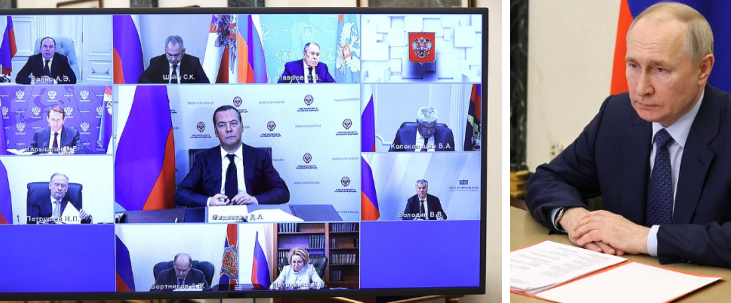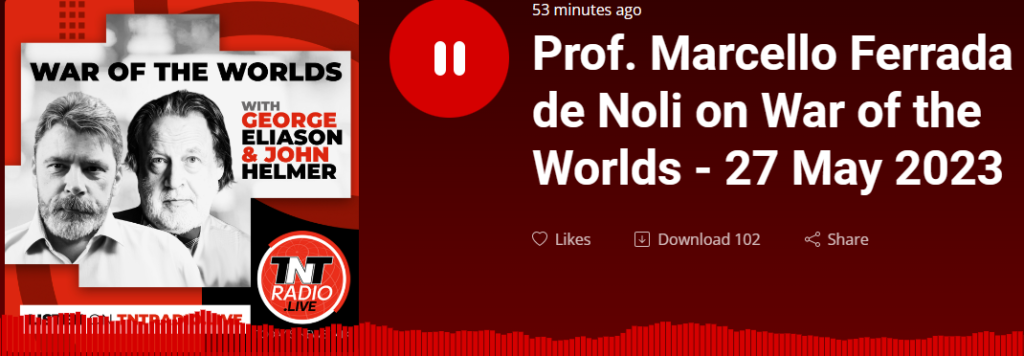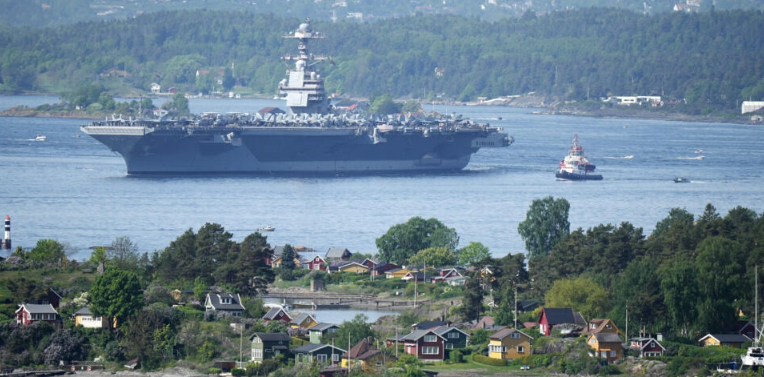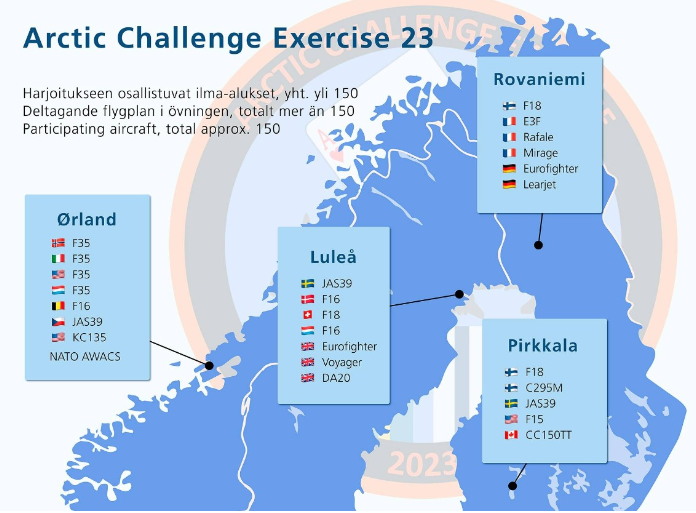 [1]
[1]
By John Helmer, Moscow
@bears_with [2]
The man in the frame is General Valery Zaluzhny, commander-in-chief of the Ukrainian Armed Forces.
There are no insignia on his jacket, zipped tight to his chin. His torso and legs are concealed beneath the desk which also accommodates a computer screen without keyboard or mouse; and a pen held between the general’s right thumb and index finger, upside down and useless. Patriotic slogans have been pasted to the wall. A wall socket accommodates a thick communications cable routed along the base of the wall, but not visibly connected to the two telephones. There are ten unopened water bottles on display, six plastic cups. A single piece of paper on the desk reveals no date. The general is able to say a dozen scripted words and raise his left hand.
He is not dead from the Russian missile attack which had caused his disappearance until this video clip was published on Thursday evening to dispel what the Ukrainian introducer called the mystery and the Russian propaganda of Zaluzhny’s death. The clip proves the opposite of this intention. The general is visibly unwell and is no longer capable of commanding the Ukrainian forces.
Ukrainian production of the Zaluzhny cameo was published on the Telegram account of the Russian war news aggregator, Rybar; the 35-second video was originally displayed at 21:59 on May 25. https://t.me/s/rybar [3]
The Rybar team commented: “Such strange behaviour of the responsible persons cannot but suggest that the rumours about the injury of Zaluzhny really do have grounds. This explains his almost month-long absence from the media field: apparently, in order to appear in public, he needed to heal at least some of his injuries. There is no special point in speculating about the current capabilities of the commander-in-chief of the Armed Forces to manage troops now: in the end, there is no objective information yet about Zaluzhny’s state of health. But we can say one thing – in the event of failures of the enemy’s armed forces, there will definitely be talk that the reason for the failures was an incapacitated general. Who, even after a serious injury, was left in office solely for political and media reasons.”
Twenty-two hours earlier, on the evening of May 24, Rybar picked up a Ukrainian attempt to make Zaluzhny appear much healthier. In that picture, an adviser to the command staff, Alyona Shevtsova, is shown with the general. However, investigation of the details of the photograph reveals it was taken at an official press opportunity on May 2, just before Zaluzhny disappeared.
 [4]
[4]Source: Rybar Telegram, May 24, 23:2 [3]7. The watch on Zaluzhny’s right wrist appears to be missing from his appearance in the video of May 25.
The significance of Zaluzhny’s month-long disappearance, and of this week’s Ukrainian efforts to restore his visibility is that if the commander-in-chief can be targeted by accurate Russian intelligence, followed by missile or drone attack, then no Ukrainian soldier, from private to general, is safe at any location in the country.
The incident also raises the question of why the US and NATO are protecting the Ukrainian president Vladimir Zelensky outside the Ukraine more effectively than they are capable of doing for Zaluzhny and his staff inside. In the past week, for example, Zelensky has been photographed disembarking in Japan from a French presidential jet. Domestically in the Ukraine, the disparity of sacrifice is all too obvious, as is the steady collapse of security for the regime in the west of the country no less than on the front in east.
 [5]
[5]Source: https://twitter.com/bears_with/ [6]
This collapse is the subject of a dramatic new statement by Dmitry Medvedev, the former Russian president and currently deputy head of the Security Council. This was published at 21:36 on May 25 [7]. For the first time a senior Russian official declared that the strategic objective of the war has now become the elimination of the Ukraine as a sovereign state, and its replacement by Russia in the east, Poland and Hungary in the west, with the possibility of a demilitarized zone in between the two.
“I recently wrote why Ukraine will disappear,” Medvedev announced. “Now it’s time to say how Ukraine will disappear, and also what will then be the risk of a resumption of the war in Europe and in the rest of the world. This will depend on which path the process of disintegration of this dying state will take as a result of the lost military conflict. There are two of them. One is the path of relatively slow erosion of Ukrainian statehood with the gradual loss of the remaining elements of state sovereignty. Alternatively, there is the path of its swift collapse with simultaneous annihilation of all signs of statehood.”
“In any case, after such a collapse, three possible scenarios are likely. In the first scenario, the western regions of Ukraine would come under the control of a number of EU states with a subsequent ‘anschluss’ [annexation] of these lands by the receiving states. At the same time, a certain ‘no-man’s-land’ would remain Ukrainian territory, squeezed between Russia and the territories which have passed under the sovereignty of a number of European countries. This remaining ownerless territory would declare its secession from the former Ukraine with its own international legal personality and with its intention to return the lost lands by all means. Naturally, this refers only to those lands which have become part of Russia. At the same time, this ‘new’ Ukraine would immediately declare its desire to join the European Union and NATO, which could happen in the medium term. The armed conflict would resume after a short time, turning into a permanent war and with the threat of its rapid escalation into a full-fledged third World War.”
“Second scenario: Ukraine disappears after it has completely dissolved in the process of its division between Russia and a number of the EU states. A government of Ukraine would then be formed in exile in one of the European countries. The war would end with reasonable guarantees of its non-renewal in the near future, but with thepreservation of the terrorist activity of the Ukrainian Nazis; they will be dispersed over the territory of the EU states which have received Western Ukrainian lands. In this case, the risk of the resumption of a full-fledged conflict or its escalation into a world war can be considered moderate.”
“Third scenario: the same thing happens as in the first case but taking the opposite direction. The western lands of Ukraine are joining a number of EU countries. The people of the central and some other ownerless regions of Ukraine, within the framework of Article 1 of the UN Charter, immediately declare their self-determination by joining the Russian Federation. This request is granted, and the war would end with sufficient guarantees of its non-renewal in the long term. There are simply no other options. And this is already clear to everyone, even if it is unpleasant for someone out there in the West to admit it.”
“ We may be temporarily satisfied with the second option, but we need a third one.”
 [8]
[8]Several hours after Medvedev published his statement [9], he participated (left image, centre) in the weekly session of the Security Council chaired by President Putin. According to the Kremlin communiqué, the only agenda item discused was “additional social guarantees for participants in the special military operation and their family members.”
Listen to the broadcast [10]for more detail and the discussion.
 [11]
[11]Internet and telephone failure prevented Swedish guest Marcello Ferrada de Noli from joining the broadcast. He will return at a later date.
In the final segment of the broadcast, the breaking news is analysed of the abrupt change of mission for the US Navy aircraft carrier, the USS Gerald Ford and its flotilla, and their deployment to Oslo, Norway, and then north and east above the Arctic Circle. When the Gerald Ford left its Norfolk, Virginia, base on May 2, the Navy announced [12]it was heading to the Mediterranean as the replacement for the USS George H.W. Bush. According to the official releases, this was the first operational deployment of the Gerald Ford with a full complement of aircraft on board. “Defense officials have told USNI News that Ford will continue the consistent carrier presence in the Mediterranean Sea, which the U.S. began in December 2021 ahead of the Russian invasion of Ukraine in early 2022. ‘Our presence at sea throughout the deployment will provide reassurance to our allies and partners that sea lanes will remain open, and our joint operations will demonstrate our commitment to interoperability and maritime stability,’ Rear Admiral Greg Huffman, the commander of Carrier Strike Group 12, said in a Navy news release [13].”
The Navy changed direction. On May 24, the Gerald Ford and its escorts docked in Oslo for what local media reported to be the first such carrier portcall in Norway in 65 years.
 [14]
[14]Source: https://www.france24.com/ [15]
The Norwegian defense minister announced [15]: “this is the concrete expression of our close relationship with the United States and demonstrates the will for collective defence and deterrence”. The Norwegian press also reported that the US carrier group would sail northeast over the Arctic Circle to join aircraft and vessels from several NATO countries for the start of the Arctic Challenge Exercise on May 29.
The NATO announcement of this exercise appeared on May 25. It identified the locations of the exercise and listed NATO state aircraft participating [16]. There was no mention of the participation of the Gerald Ford. A Finnish Air Force announcement [17] also omitted reference to the US Navy flotilla.
According to the operational maps published so far, the exercise area of Norway, Sweden, and Finland is in the Norway and Barents Seas, more than one thousand kilometres northeast of St. Petersburg.
 [18]
[18]Source: https://ac.nato.int/ [16]
A Russian statement on the new carrier force deployment called it “illogical and harmful. There are no issues in the North that require a military solution,nor issues that require outside intervention,” the Russian Embassy published on its Twitter account [19]. There has been no response from Moscow to date.
Responding to these developments, a Moscow security analyst comments: “Let’s say the Americans despite all these military warnings and threats do nothing, and stick to supplying newer, and what they think are better weapons and systems. At the same time the Ukrainians continue their random cross-border raids, and on the Donbass front try a major push in this or that direction. The Russians will do what in response? Wait until the winter and in the meantime intensify the targeting of the electricity infrastructure and the weapons and fuel storages?
“If Russians can keep the toll high enough through this warfare, there has to be a tipping point for a country of now less than 20 million that it cannot keep up. And then the big question will be, Who gives? Will Zelensky be usurped by the neo-Nazis and Poles and Hungarians who will stop the fighting for the sake of Donbass and to keep their Anschluss with the motherlands? To me, this looks like a very workable strategy for doing nothing except very targeted strikes for a whole year or two. “
“With Germany now in recession, the UK most likely to follow, and then Italy and France not far behind, there will be a very significant depletion of public support for war and the tide will rise against Ukrainians refugees. That means Russia has to keep the war going for a couple of years because sanctions won’t ease, but it does not have to make human sacrifices to win. There is no need to rush it.”